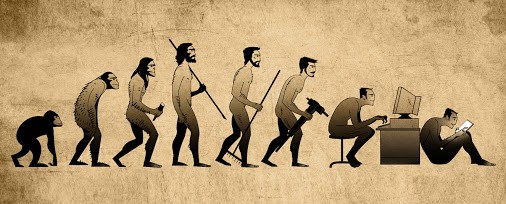
Advertisement
Science is a recent enterprise to take humanity by storm. Despite its infancy, science has made rapid progress. But in order to understand where science can take us, it’s important to understand its roots, which have been been oversimplified – and in many cases, skewed – by mainstream television.
Anyone looking to refresh their memory in the history of science would be well-advised to pick up a copy of Alexander Hellemens’s book, The Timetables of Science: A chronology of the most important people and events in the history of science. The following is a snippet from the book, which explains how something as simple as tool making ballooned into the cultivation of the world’s greatest economies.
The hunter-gatherers
The progress in technology is most clearly seen in the further refinement of stone tools. While H. erectus had used essentially the same tool kit for 1.5 million years, H. sapiens invented new forms of stone tools at a progressively faster rate before largely abandoning stone tools for metal ones some 7000 to 8000 years ago. Metal tools were preceded by bone tools, such as needles, that could not have been easily made from stone. Although remains are scarce in the archaeological record, there is no doubt that similar progress was being made in tools of more perishable materials, especially wood. Hunting weapons, such as the sling, the bow, the bolo, the fish hook, and the spear thrower, are among the technological innovations of this period. Although most early wooden tools have vanished, some of these inventions can be seen in early paintings.

There is also some evidence that mathematics and astronomy, which have been linked throughout most of history, were in use. Notches on artifacts have been interpreted as tally marks or counters, as calendars, and as records of the lunar cycle.
Other evidence of astronomy is less certain. Various early structures have been theorized to be observatories, but most of these interpretations are controversial. Traditions that seem to go very far back in Egypt and in Central America are associated with specific apparent motions of Sirius and Venus. Although we know of these traditions from a much later period, it seems likely that primitive hunter-gatherers had already detected patterns in the apparent motions of the stars and possibly even in the real motions of the planets through the night sky.
Hunter-gatherers living today have an extensive knowledge of wild animals and plants; there is no reason to expect that this was not also true of early hunter-gatherers. Early botanical taxonomy was undoubtedly accurate, for if it were not, people would not have known which plants were good for food. It is also likely that knowledge of plants whose chemical properties are useful as poisons, dyes, or medicines had its beginnings during the hunter-gatherer period.
The agricultural revolution
Starting about 10,000 years ago, people made the major technological advance of domesticating animals and plants. This occurred independently in the Middle East, the Orient, and the Americas. At one time, historians assumed that the agricultural revolution was simply a form of progress. This interpretation is now in dispute. Historians now hypothesize that people knew how to raise crops and keep animals earlier, but were reluctant to do so until either rising population or reduced natural food supplies forced them into agriculture. This is partly supported by a rise in population preceding the adoption of agriculture, as indicated in the archaeological record. Another supporting element is that modern hunter-gatherers know about agriculture, but think it is too much work.
Another belief that has largely been discarded is that urban life began a result of the agricultural revolution. Towns were forming before farming became a way of life. The principal purpose of preagricultural settlements was trade. Towns arose at the juncture of trade routes or near supplies of goods that could be traded. Jericho, for example, was founded well before agriculture started.
It is hard to find any evidence of the physical sciences around the time of the agricultural revolution except for that implied by developing technology, such as the introduction of sun-dried bricks and mortar. Major developments of the period following the agricultural revolution were largely in astronomy, mathematics, and technology.
Civilization
Following the agricultural revolution, societies that we recognize as civilizations began to arise. It is thought that the need to maintain stability after the annual flood contributed to a strong central state in Egypt, while centralized control of irrigation projects was the stimulus in Mesopotamia. Less is known about the origins of the other early civilizations, the Indus culture, centered at Harap-pa and Mohenjo-Daro in the Punjab region of India, and the early Chinese empire. All were flourishing by about 3000 BC.
Our understanding of these cultures has been influenced by the way we became aware of them. Egypt was well known to the Greeks, archaeology began there under Napoleon, and we have known how to read hieroglyphics since the work of Jean Champollion and Thomas Young in 1822. For these reasons, Egyptian culture is well understood. Many of the Mesopotamian civilizations were familiar from the Bible’s Old Testament. Other civilizations in the Americas were unknown to the Western world until after the fifteenth century. The early Maya in Central America, the Olmecs in Mexico, and various civilizations in South America domesticated plants and animals, used medical skills for mummifying and trephining (cutting holes in the skull), and built stone monuments. The Maya, especially, developed elaborate numerical and calendrical systems, along with a way of writing that is only now being deciphered.
History isn’t history. Order a copy of Hellemans’s book by clicking on this link.
Sources include:
(1) Helleman, Alexander. The Timetables of Science: A chronology of the most important people and events in the history of science. Simon and Schuster; First Edition edition. 1998.
This article may contain statements that reflect the opinion of the author
Advertisement
Advertisements















